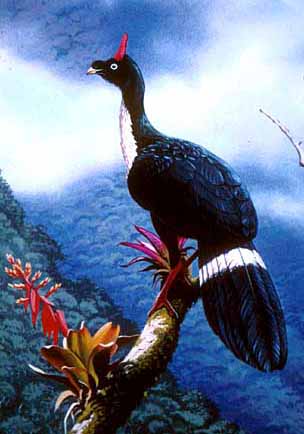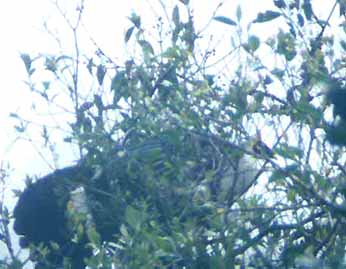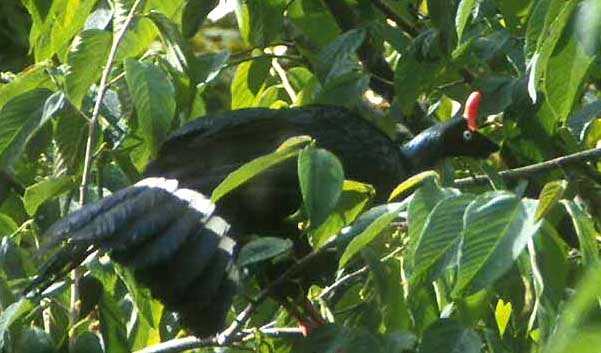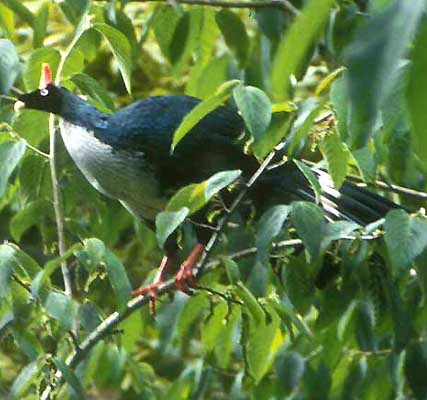
ENDANGERED & THREATENED BIRDS OF THE WORLD

 This fabulous Al Gilbert painting of Horned Guan, published
in Delacour & Amadon (1973), is my favorite piece of bird art and is
the most influential bird painting in my life. This Internet scan does
not do justice to the published painting's detail, but look at the moss-covered
limb, the red epiphytes, the unbroken pristine forest stretching out to
the clouds beyond... and then the bird! To trek to the fog-draped cloud
forest in southern Mexico and have a chance to see this huge guan with
its unworldly red horn became a major goal for me. Delacour & Amadon
(1973), a classic family monograph in the traditional mold and among the
best family books ever published, was full of stories of adventure in tracking
down rare cracids, and none was so rare and little known as this near-mythical
apparition. The book arrived just about the time I got a hand-written letter
from my teenage friend, Ted Parker, who in April 1973 set out on an expedition
to the El Triunfo cloud forest for the guan. He and colleagues saw one
magnificent adult, and local horsemen brought them two just downy youngsters
found in the forest -- the first such young known to science. Ted's enthusiasm
for the remote montane woodlands further inspired me. [An account of Ted's
trip was published in Parker, Hilty & Robbins (1976)]. I listed Horned
Guan as #7 on the first "top 50 birds of the world" list that I put
together about 1975 (with various additions and deletions since then, it
currently stands at #6 on my
"top 50 birds" list).
This fabulous Al Gilbert painting of Horned Guan, published
in Delacour & Amadon (1973), is my favorite piece of bird art and is
the most influential bird painting in my life. This Internet scan does
not do justice to the published painting's detail, but look at the moss-covered
limb, the red epiphytes, the unbroken pristine forest stretching out to
the clouds beyond... and then the bird! To trek to the fog-draped cloud
forest in southern Mexico and have a chance to see this huge guan with
its unworldly red horn became a major goal for me. Delacour & Amadon
(1973), a classic family monograph in the traditional mold and among the
best family books ever published, was full of stories of adventure in tracking
down rare cracids, and none was so rare and little known as this near-mythical
apparition. The book arrived just about the time I got a hand-written letter
from my teenage friend, Ted Parker, who in April 1973 set out on an expedition
to the El Triunfo cloud forest for the guan. He and colleagues saw one
magnificent adult, and local horsemen brought them two just downy youngsters
found in the forest -- the first such young known to science. Ted's enthusiasm
for the remote montane woodlands further inspired me. [An account of Ted's
trip was published in Parker, Hilty & Robbins (1976)]. I listed Horned
Guan as #7 on the first "top 50 birds of the world" list that I put
together about 1975 (with various additions and deletions since then, it
currently stands at #6 on my
"top 50 birds" list).
I believe it was in 1977 that Victor Emanuel organized the first bird tour to El Triunfo. He became close friends with the Don Rodrigo and this family who provided the horses to carry participants' gear and a week's worth of food from Tres de Mayo, at just 900' elevation on the dry Pacific slope to the cloud forest at 6800' elevation at Triunfo, crossing a 7000' ridge enroute. Victor Emanuel Nature Tours (VENT) has offered El Triunfo tours for the 25 years since then (excepting a couple years when Zapatista uprisings made travel less safe). In 1986, I joined such a tour and hiked the 22 miles over three days to El Triunfo up the Pacific side, and then after several days in the cloud forest, returned the same route. This was a very physically demanding hike but the scenery was spectacular and the birding good. Alas, in 1986 only 2 of 12 of us saw a Horned Guan, and I wasn't one of them. It was a very dry year with fruiting trees few and dispersed, and guans were at low numbers (perhaps 50 in the recently-established El Triunfo reserve). Even though we sent a runner to bring Ismael Galvez-Galvez -- who grew up in the El Triunfo clearing and is the world's best Horned Guan tracker -- even he could not locate one for us that year.
 I
resolved to return to El Triunfo before I was 50 and while I could still
make the hike. By the late 1990s VENT was offering El Triunfo trips from
the "back side" (i.e., from the east slope); one now hikes up "just" 8
miles from Finca Prusia, a coffee farm at 4450' elevation, and then one
continues down the "front" (Pacific) side over 4 days (not just 3 as before).
This makes it all much more pleasant although it is still a strenuous 30
hike in total and ten days camping. I turn 50 in 2002, and so March 2002
found me back on the VENT trip for a return trip, led by Victor Emanuel,
Greg Lasley & Brad Boyle, and Ishmael Galvez-Galvez as our guan tracker.
The adventure featured the greatest contrasts in 25 years with constant
rain and blowing gales for two days on top and beastly hot weather down
the Pacific side. But we hit the fruit just right and by now Horned Guan
numbers were up to perhaps 100. We had a calling male Horned Guan
on the high ridge during the hike in the first day, and I actually was
the one to first find it. I hear the low humming song (um-uuuum-um)
and took off my backpack & gear to search for it. It wasn't until Ishmael
arrived, however, that he spotted the male well up the ridge standing on
a huge mossy limb -- not unlike that Gilbert painting. We saw another (or
the same?) male eating fruit in a ridgeline canopy the next morning (right
or above), using its huge tail to balance in the tree top in the gale..
I
resolved to return to El Triunfo before I was 50 and while I could still
make the hike. By the late 1990s VENT was offering El Triunfo trips from
the "back side" (i.e., from the east slope); one now hikes up "just" 8
miles from Finca Prusia, a coffee farm at 4450' elevation, and then one
continues down the "front" (Pacific) side over 4 days (not just 3 as before).
This makes it all much more pleasant although it is still a strenuous 30
hike in total and ten days camping. I turn 50 in 2002, and so March 2002
found me back on the VENT trip for a return trip, led by Victor Emanuel,
Greg Lasley & Brad Boyle, and Ishmael Galvez-Galvez as our guan tracker.
The adventure featured the greatest contrasts in 25 years with constant
rain and blowing gales for two days on top and beastly hot weather down
the Pacific side. But we hit the fruit just right and by now Horned Guan
numbers were up to perhaps 100. We had a calling male Horned Guan
on the high ridge during the hike in the first day, and I actually was
the one to first find it. I hear the low humming song (um-uuuum-um)
and took off my backpack & gear to search for it. It wasn't until Ishmael
arrived, however, that he spotted the male well up the ridge standing on
a huge mossy limb -- not unlike that Gilbert painting. We saw another (or
the same?) male eating fruit in a ridgeline canopy the next morning (right
or above), using its huge tail to balance in the tree top in the gale..
Our group had Horned Guans every day at El Triunfo in March 2002. My best experiences were on the fabulous 23rd of March (anniversary of seeing a Tiger in India). I joined Victor, Ismael, and a few others on a hike out the Palo Gordo trail to where it begins zigzagging up a ridge and passes a fruiting mulberry tree. Four Horned Guans (two adults, two immature by horn size) were eating fruit here throughout the morning, and we spent over an hour watching them. Despite patches of sunshine, most of my handheld photos were at 1/30th to 1/90th of a second and most are a bit wobbly, but I very much like this one:

 As
it turns out, the Horned Guan is a very arboreal cracid, rarely coming
to the ground. This was discovered by Fernando González-García
when he did his major study of the guan's basic biology, following birds
about all day for weeks on end (many details published in González-García
1994, 1995). A number of earlier authors had considered it (wrongly) to
be mostly terrestrial. In fact, it comes to the ground primarily to dust-bathe
only once a day, at least in the dry season (details in González-García
1994). They also do some courting during these baths and some nests have
been on the ground. Typically two eggs are laid, thus leading to the two
babies brought to Ted Parker back in '73 (these were taken to the Tuxtla
Gutierrez zoo and one lived several decades).
As
it turns out, the Horned Guan is a very arboreal cracid, rarely coming
to the ground. This was discovered by Fernando González-García
when he did his major study of the guan's basic biology, following birds
about all day for weeks on end (many details published in González-García
1994, 1995). A number of earlier authors had considered it (wrongly) to
be mostly terrestrial. In fact, it comes to the ground primarily to dust-bathe
only once a day, at least in the dry season (details in González-García
1994). They also do some courting during these baths and some nests have
been on the ground. Typically two eggs are laid, thus leading to the two
babies brought to Ted Parker back in '73 (these were taken to the Tuxtla
Gutierrez zoo and one lived several decades).
Details of its range and habits were published by Andrle (1966), Delacour & Amadon (1973) and Parker et al. (1976). Although the Horned Guan is restricted to the cloud forest of extreme southwestern Mexico and adjacent Guatemala, birds do wander in search of food and have been recorded from 1200m (3900') to 3500m (11,500') elevation. The core range, though, is 2000-3000m (6500'-9700'). The 1967 paper by Robert Andrle is particularly interesting because it includes a photo of the El Triunfo clearing back in those days, and the frontispiece of that issue of The Condor is another Al Gilbert painting of Horned Guan.
González-García (1994, 1995) showed that Horned Guans spend most of their time in the trees, eating fruit, preening, and sleeping. In one 8 hour stretch, for example, the male that was followed spent 2 hours eating and 6 hours in preening or other comfort behavior. This is exactly what we observed during our visit. Our four guans were eating "mulberries" but González-García (1994) detailed observations of them eating 37 plant species (fruit or leaves), the most common of which were Nectandra reticulata, Conostegia volcanalis, Citharexylum mocinnii, and Morus insignes. Horned Guans are exceptional among the cracids in that they also feed their young only fruit and leaves (no animal food). Just brings tears to the eyes of this vegetarian birdwatcher (ahem)....
The number of Horned Guans in the world is unknown but has been thought to be less than 1000 birds; it is formally listed worldwide as "endangered" (Birdlife International 2000). For me personally, it was exceptionally satisfying to finally see the 'holy grail' Horned Guan. And then to take photos! Oh, happy day....
Much more information on my El Triunfo trips is on-line at this button below. An avifaunal survey was published by Gomez de Silva Garza et al. 1999).
You can reach Victor Emanuel Nature Tours at this link. I recommend doing the trip with them because of the logistics, the expertise of the guides and their tapes (very helpful with many shy and difficult birds, if not the Horned Guan), and mostly because VENT as done much over the last quarter-century to promote protection of El Triunfo and solidify that protection by getting money into the local economy. Don Rodrigo has passed one but we met his widow in 2002 and his family continues to provide the horses annually for the El Triunfo adventure trek. However, it is possible to arrange your own trip through El Triunfo Biosphere Reserve and their ecotourism project. They can arrange pack animals and transport to the trailhead from Tuxtla Gutierrez. You will definitely want to visit in the dry season (January-June; March-April best) as the trails are essentially impassable during the rains. It can rain at any time but rains start about May and intensify July-October. The Reserve has recently posted an El Triunfo Biosphere Reserve web site (currently in Spanish only) with a variety of photos.
EL TRIUNFO
TRIP REPORT
ARTWORK: The Albert Earl Gilbert painting was published in Delacour & Amadon (1973). See the Wildlife Art of Albert Earl Gilbert web site for more information about his work.
PHOTOS: All photos were taken at El Triunfo, Chiapas, Mexico, in March 2002. All are © 2002 Don Roberson, all rights reserved.
Literature cited:
Andrle, R. 1966. Horned Guan in Mexico and Guatemala. Condor 69: 93-109.TOPBirdlife International. 2000. Threatened Birds of the World. Barcelona & Cambridge, U.K., Lynx Edicions & Birdlife International.
Delacour, J., and D. Amadon. 1973. Curassows and Related Birds. Amer. Mus. Nat. Hist., New York.
González-García, F. 1994. Behavior of Horned Guans in Mexico. Wilson Bull. 106: 357-365.
González-García, F. 1995. Reproductive biology and vocalisations of the Horned Guan Oreophasis derbianus in Mexico. Condor 97: 415-426.
Gomez de Silva Garza, H., F. Gonzalez-Garcia, and M. P. Casillas-Trejo. 1999. Birds of the upper cloud forest of El Triunfo, Chiapas, Mexico. Ornith. Neotrop. 10: 1-26.
Parker, T. A. III, S. Hilty, and M. Robbins. 1976. Birds of El Triunfo cloud forest, Mexico, with notes on the Horned Guan and other species. Amer. Birds 30: 779-782.
TO ENDANGERED & THREATENED BIRDS ENTRY PAGE